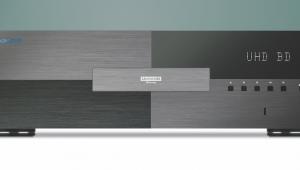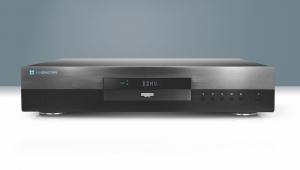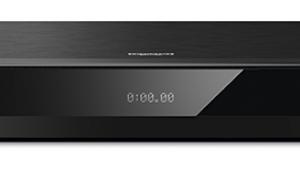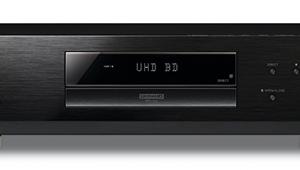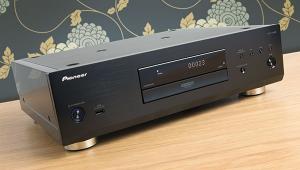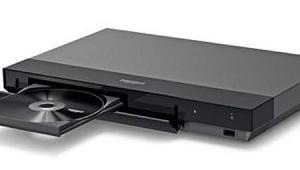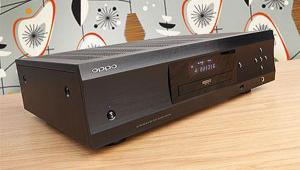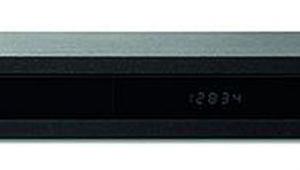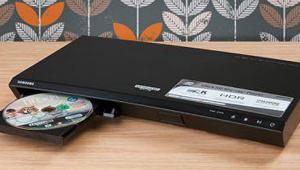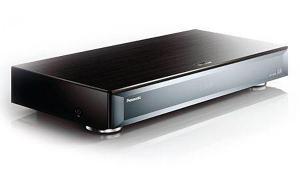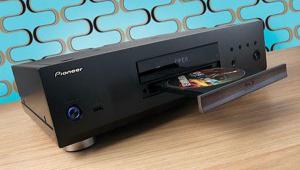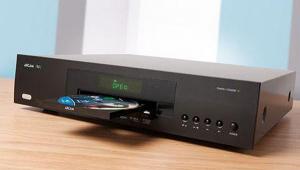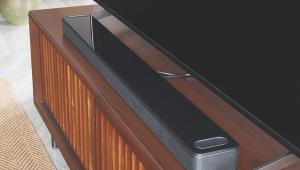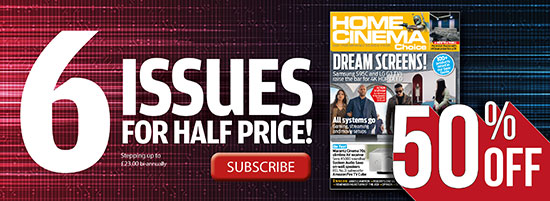Oppo BDP-105D Blu-ray player review

 The Oppo BDP-105D is a spectacular antidote to the rash of lightweight cheapies that have come to define the mainstream Blu-ray player market. A fabulously engineered heavyweight disc-spinner that in this latest iteration inches even further into audiophile streaming territory.
The Oppo BDP-105D is a spectacular antidote to the rash of lightweight cheapies that have come to define the mainstream Blu-ray player market. A fabulously engineered heavyweight disc-spinner that in this latest iteration inches even further into audiophile streaming territory.
A refreshed version of the reference status BDP-105EU launched last year, the BDP-105D may not be significantly different for the Oppo faithful to warrant trading up to, but it is sufficiently pimped to demand a fresh look.
The BDP-105D has the stature of a small AV receiver, but build quality is ferociously good. The front fascia, seemingly hailing from Tony Stark's own ironmongery, has a stylised trim that comes into its own when the light falls a particular way. The disc-loading tray slides out with refined deliberation, rather than clattering urgently. Pride of ownership definitely comes into play here.
To the right of the central disc tray are HDMI and USB ports (the former with support for MHL smartphone connection), plus a full-size headphone jack with a high-grade headphone amplifier that connects directly to one of the deck’s two 32-bit Sabre DACs.
So straight from the off, you know this isn't a regular BD deck, and the rear of the unit adds to that feeling. For one thing, there are both phono and balanced XLR stereo outputs, the latter allowing hookup to suitable active speakers or XLR-equipped amplification. This balanced stereo output provides an alternate connection from the deck's DAC, with the promise of less noise and superior signal reproduction.
There’s also a full 7.1 set of phono audio outputs. The rub, of course, is that a growing majority of AV receivers no longer offer a multichannel audio input. Yet for some this connectivity may remain a lure.
The BDP-105D boasts an HDMI loop-through, in addition to a pair of outputs. This dual output can be configured as a split feed, with video going through HDMI 1 and audio through HDMI 2, or as a Dual Display that outputs the same AV to different displays simultaneously. This is welcome flexibility.
There are also two sets of optical and coaxial digital audio inputs. One pair is flanked by an asynchronous USB-B port which supports 192kHz/24-bit streaming from a connected laptop. There are also two rear USB-A inputs, one of which is intended for the wireless dongle which is provided in the box, should you not be able to make use of the Ethernet connection.

Those familiar with the standard Oppo interface and menu structure will find nothing has changed here. Key icons offer access to either a loaded disc, or music, video and photo files. A Network icon opens up your LAN and all the compliant devices you may have lurking there, be they PC or NAS, while the Settings tab offers refuge for tweakers.
Network file support for both sound and vision is excellent. All popular audio codecs and video containers can be played – AAC, WAV, MP3, FLAC, DSD, Ogg Vorbis and WMA audio files, along with MPEG-2, AVI, MOVs and MKVs. Files that combine MKV with FLAC audio, and have defeated lesser media players on my test bench, are unwrapped with ease.
This isn’t a player with much in the way of IPTV services. There’s a small selection of apps comprising Netflix, BBC iPlayer, YouTube, Picasa, BBC News and Sport. You also get a range of non-functioning apps, at least as far as UK users are concerned, including CinemaNow, Film Fresh, Pandora and Vudu. This is beginning to irritate.
A dual-core processor means the Oppo is speedy, both when it comes to navigating the UI and loading a disc. The Java-lite Lou Reed concert platter Berlin goes from open tray to menu in just 22 seconds. The more complex Goldfinger delivers its menu in 47 seconds.
One of the more interesting features on the BDP-105D is Darbee Visual Presence. This offers three types of image processing, with variable intensity on each: Full Pop, Hi-def and Game. What exactly is Darbee doing? To shed some light on the processing in action, I used a 1080p monoscope with Darbee effects visible in a scrolling split screen.
On Full Pop, it was clear that the processor was creating intrusive imaging artefacts when used at more than 20 per cent; the higher the processing power the worse the smeary effect. At less than 20 per cent, the artefacts became undetectable, but then so did any major benefit. Both the Hi-Def and Gaming modes prove less disruptive, but outside of a minor contrast lift I personally can't see any reason to indulge it. Some of my colleagues are more amenable to it – feel free to experiment.
Frankly, this Oppo doesn’t need additional help. In terms of visual acuity, the BDP-105D is natively sublime. HD images offer monumental detail and texture retrieval. This player, coupled to an upscaled 4K display (a Sony X9) delivers an almost holographic image. Anyone arguing that Gravity can only really be appreciated in a cinema needs to get an eyeful of this combo.
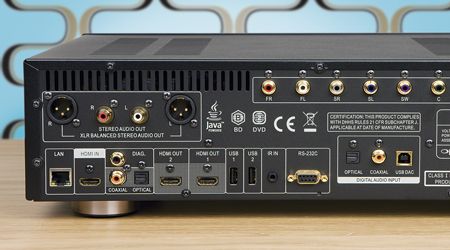
Sonically, the Oppo takes anything in its stride. Overture: The Earth by Kosuke Yamashita, in 96kHz/24-bit 7.1 Dolby TrueHD sounds positively majestic; spacious and crystal clear. And, of course, CDs can take advantage of the deck’s excellent DAC, outputting high-fidelity analogue stereo.
While the BDP-105D largely shows all other players in its price range a clear pair of heels, there are elements to the spec that not everyone will want or need. I’ll wager that those XLR connections will find employment in a relatively limited number of systems, and, personally speaking, I don’t want a laptop anywhere near my AV system.
However, if you’re interested in DSD as a high-quality music option then the player’s new support over USB will be welcome. From a practical of view, the sheer size of DSD remains a deterrent to general adoption (far better to invest in Blu-ray Pure Audio discs, which this Oppo was born to play), but the file format certainly sounds sensational. SACD and DVD-A discs are also supported as a matter of course.
Interestingly, the BDP-105D can play both DSD 64 stereo and multichannel DSD files (I used content from 2L). However it failed to play my 2L-sourced Double DSD test files from USB media, even though support is claimed – perhaps a firmware update will solve this. The deck doesn’t play any DSD across a network.
While I would normally advocate system builders opt for a separate DAC – not least because of the enormous choice and increasing performance of what’s available, there’s no doubt that this Sabre-toothed Oppo competes at a very high level.
Overall, the BDP-105D retains its reference status, not least because of the bravura nature of its AV chops and that positively divine construction. While I’m unconvinced by the Darbee processor, and acknowledge that certain aspects of the spec are eclectic at best, this remains the player to beat if you’re looking to make the most of your disc and file collection. Immensely versatile, this is Blu-ray at its brilliant best.
Specification
3D: Yes
Upscaling: Yes. To 4K using Qdeo processor
Multiregion: No. Region B BD/R2 DVD
HDMI: Yes. 2 x v1.4 outputs (with ARC); 2 x v1.4 inputs (one front-mounted, MHL compatible)
Component: No
Multichannel analogue: Yes. 7.1 and stereo phono; stereo balanced
Digital audio: Yes. Coaxial and optical inputs; coaxial and optical outputs
Ethernet: Yes
Built in Wi-Fi: No, but Wi-Fi dongle is supplied
SACD /DVD-A: Yes/Yes
Dolby TrueHD/DTS-HD decoding: Yes
Dolby TrueHD/DTS-HD bitstream: Yes
Dimensions: 430(w) x 123(h) x 311(d)mm
Weight: 7.9kg
Features: Asynchronous USB-B DAC input; Darbee Visual Presence processor; digital volume on all analogue outputs; Gracenote look-up for all music inputs with cover art display; 3 x USB ports; app control; bespoke toroidal power supply; dedicated headphone amplifier; DLNA media playback with DMP and DMR features; extensive file support including MKV, AVI, MOV, MPEG, MP3, WMA, WAV, FLAC, DSD; RS-232 control; IR port, fanless design
 |
Home Cinema Choice #351 is on sale now, featuring: Samsung S95D flagship OLED TV; Ascendo loudspeakers; Pioneer VSA-LX805 AV receiver; UST projector roundup; 2024’s summer movies; Conan 4K; and more
|

